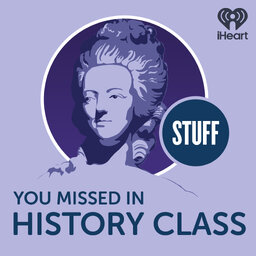Sir Humphry Davy and the Miner’s Lamp (Part 2)
Davy's career after his work in nitrous oxide included the invention of a miner's lamp designed to make mining safer. This invention came with a bit of controversy.
Research:
- "Britons take laughing gas merrily. Tories take it more seriously." The Economist, 27 Sept. 2023, p. NA. Gale OneFile: Business, link.gale.com/apps/doc/A766770794/GPS?u=mlin_n_melpub&sid=bookmark-GPS&xid=c0888abb. Accessed 3 Apr. 2024.
- "Erroneous element." Muse, vol. 20, no. 7, Sept. 2016, p. 7. Gale General OneFile, link.gale.com/apps/doc/A466296806/GPS?u=mlin_n_melpub&sid=bookmark-GPS&xid=795a6d0c. Accessed 3 Apr. 2024.
- “Sir Humphrey Davy’s Harmful Emissions – November 2015.” Newcastle University Special Collections. 11/30/2015. https://blogs.ncl.ac.uk/speccoll/2015/11/30/sir-humphrey-davys-harmful-emissions/
- Adams, Max. "Humphry Davy and the murder lamp: Max Adams investigates the truth behind the introduction of a key invention of the early Industrial Revolution." History Today, vol. 55, no. 8, Aug. 2005, pp. 4+. Gale In Context: U.S. History, link.gale.com/apps/doc/A135180355/GPS?u=mlin_n_melpub&sid=bookmark-GPS&xid=2d163818. Accessed 3 Apr. 2024.
- Buslov, Alexander BSc; Carroll, Matthew BSc; Desai, Manisha S. MD. Frozen in Time: A History of the Synthesis of Nitrous Oxide and How the Process Remained Unchanged for Over 2 Centuries. Anesthesia & Analgesia 127(1):p 65-70, July 2018. | DOI: 10.1213/ANE.0000000000003423
- Cantor, Geoffrey. “Humphry Davy: a study in narcissism?” The Royal Society. 4/11/2018. https://royalsocietypublishing.org/doi/10.1098/rsnr.2017.0055#FN95R
- Cartwright, F.F. “Humphry Davy’s Researches on Nitrous Oxide.” British Journal of Anesthesia. Vol. 44. 1972.
- Davy, Humprhy. “Researches, chemical and philosophical : chiefly concerning nitrous oxide, or diphlogisticated nitrous air, and its respiration.” London : printed for J. Johnson, St. Paul's Church-Yard, by Biggs and Cottle, Bristol. 1800.
- Eveleth, Rose. “Here’s What It Was Like to Discover Laughing Gas.” Smithsonian. 3/27/2014. https://www.smithsonianmag.com/smart-news/heres-what-it-was-discover-laughing-gas-180950289/
- Gibbs, Frederick William. "Sir Humphry Davy". Encyclopedia Britannica, 26 Feb. 2024, https://www.britannica.com/biography/Sir-Humphry-Davy-Baronet. Accessed 3 April 2024.
- Gregory, Joshua C. “The Life and Work of Sir Humphry Davy.” Science Progress in the Twentieth Century (1919-1933), Vol. 24, No. 95. https://www.jstor.org/stable/43428894
- Hunt, Lynn and Margaret Jacob. “The Affective Revolution in 1790s Britain.” Eighteenth-Century Studies , Summer, 2001, Vol. 34, No. 4 (Summer, 2001). https://www.jstor.org/stable/30054227 j
- Jacob, Margaret C. and Michael J. Sauter. “Why Did Humphry Davy and Associates Not Pursue the Pain-Alleviating Effects of Nitrous Oxide?” Journal of the History of Medicine and Allied Sciences , APRIL 2002, Vol. 57, No. 2. Via https://www.jstor.org/stable/24623678
- James, Frank A. J. L. "Davy, Humphry." Complete Dictionary of Scientific Biography, vol. 20, Charles Scribner's Sons, 2008, pp. 249-252. Gale In Context: U.S. History, link.gale.com/apps/doc/CX2830905611/GPS?u=mlin_n_melpub&sid=bookmark-GPS&xid=c68d87c2. Accessed 3 Apr. 2024.
- James, Louis. “’Now Inhale the Gas’: Interactive Readership in Two Victorian Boys' Periodicals, 1855–1870.” Victorian Periodicals Review, Volume 42, Number 1, Spring 2009. https://doi.org/10.1353/vpr.0.0062
- Jay, Mike. “‘O, Excellent Air Bag’: Humphry Davy and Nitrous Oxide.” 8/6/2014. Public Domain Review. https://publicdomainreview.org/essay/o-excellent-air-bag-humphry-davy-and-nitrous-oxide/
- Jay, Mike. “The Atmosphere of Heaven: The 1799 Nitrous Oxide Researches Reconsidered.” Notes and Records of the Royal Society of London , 20 September 2009, Vol. 63, No. 3, Thomas Beddoes, 1760-1808 (20 September 2009). https://www.jstor.org/stable/40647280
- Knight, David. "Davy, Sir Humphry, baronet (1778–1829), chemist and inventor." Oxford Dictionary of National Biography. February 10, 2022. Oxford University Press. Date of access 3 Apr. 2024, https://proxy.bostonathenaeum.org:2261/view/10.1093/ref:odnb/9780198614128.001.0001/odnb-9780198614128-e-7314
- Lacey, Andrew. “Humphry Davy and the ‘safety lamp controversy’.” 7/22/2015. https://www.theguardian.com/science/the-h-word/2015/jul/22/humphry-davy-lamp-controversy-history-science
- Neve, Michael. "Beddoes, Thomas (1760–1808), chemist and physician." Oxford Dictionary of National Biography. October 03, 2013. Oxford University Press. Date of access 11 Apr. 2024, https://proxy.bostonathenaeum.org:2261/view/10.1093/ref:odnb/9780198614128.001.0001/odnb-9780198614128-e-1919
- Polwhele, Richard. “Poems; Chiefly, The Local Attachment; The Unsex'd Females; The Old English Gentleman; the Pneumatic Revellers; and The Family Picture, Etc: Volume 5.” 1810.
- Roberts, Jacob. “High Times: When does self-experimentation cross the line?” Science History Institute Museum and Library. 2/2/2017. https://www.sciencehistory.org/stories/magazine/high-times/
- Slosson, Edwin E. “A New Path to Oblivion.” The Scientific Monthly, Vol. 17, No. 3 (Sep., 1923). Via JSTOR. https://www.jstor.org/stable/3693060
- Thomas, John Meurig. “Sir Humphry Davy and the coal miners of the world: a commentary on Davy (1816) ‘An account of an invention for giving light in explosive mixtures of fire-damp in coal mines’.” Philosophical Transactions of the Royal Society. 4/13/2015. https://royalsocietypublishing.org/doi/10.1098/rsta.2014.0288
- Thomas, John Meurig. “Sir Humphry Davy: Natural Philosopher, Discoverer, Inventor, Poet, and Man of Action.” Proceedings of the American Philosophical Society , JUNE 2013, Vol. 157, No. 2. Via JSTOR. https://www.jstor.org/stable/24640238
- West, John B. “Humphry Davy, nitrous oxide, the Pneumatic Institution, and the Royal Institution.” American Journal of Physiology-Lung Cellular and Molecular Physiology. Volume 307, Issue 9. Nov 2014. https://journals.physiology.org/doi/epdf/10.1152/ajplung.00206.2014
- Woods, Gordon. "Sir Humphry Davy." Chemistry Review, vol. 14, no. 4, Apr. 2005, pp. 31+. Gale General OneFile, link.gale.com/apps/doc/A131857918/GPS?u=mlin_n_melpub&sid=bookmark-GPS&xid=4d341a27. Accessed 3 Apr. 2024.
 Stuff You Missed in History Class
Stuff You Missed in History Class


